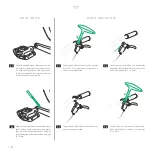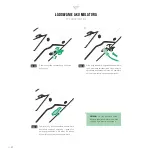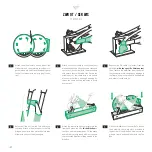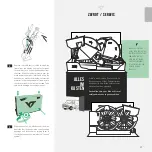
1 1 2
y t
A D J U S T I N G T H E S U S P E N S I O N E L E M E N T S
( R E A R S H O C K A N D S U S P E N S I O N F O R K )
The suspension elements we use allow for a variety
of adjustments. When making adjustments, please
note the detailed instructions of the suspension
element manufacturer. You can find up-to-date
information on their websites:
FOX:
http://www.ridefox.com
RockShox:
http://www.sram.com/en/rockshox
C A U T I O N !
N E V E R O P E R A T E YO U R B I CYC L E
W I T H I N S U F F I C I E N T O R E XC E S S A I R
P R E S S U R E ! T H I S C O U L D R E S U LT I N D A M A G E
T O T H E F O R K O R S H O C KS.
B A S I C S E T T I N G S
The weight of the rider and his position on the bi-
cycle determine the adjustment criteria for the rear
shock and suspension fork. When sitting on the bike,
the suspension will compress to a certain degree –
the so-called ″sag″. Sag should be between 25 – 30 %
for Enduro bikes, between 30 – 40 % for Downhill
bikes, and between 10 – 20 % for Dirt bikes. The ″sag
value″ that corresponds to your riding style is best
determined with a few test rides. Test rides and per-
sonal preferences will also determine the settings of
the compression and rebound speeds of the suspen-
sion elements.
C A U T I O N !
P L E A S E N O T E
Your bike’s handling is influenced by each and every
adjustment to the suspension elements – therefore,
please be careful on your first test rides to avoid
crashes. Avoid any adjustments that could lead to
the suspension elements frequently bottoming out.
They will thank you with a long service life. If you are
uncertain of anything or have any questions, do not
hesitate to contact us at:
G E T T O K N O W YO U R B I K E
Familiarize yourself with your new bike. Verify once
again that all screws are tightened to the correct
torque. Our bikes are equipped with modern disc
brake systems with exceptional braking performance.
In addition, the braking performance increases after a
short break-in period. Try to get used to the braking
response and how it differs when riding over various
surfaces. Position the brake levers at your fingertips
so that they can be pulled without excessive effort.
The same applies to the shifters. Shift smoothly and
without applying too much pressure on the pedals.
This will help protect your drive train components.
Please choose a safe and familiar terrain for your ini-
tial test and training rides. You can find all you need to
know about your bike in our ″SAFETY FIRST.″- manual
as well.
Familiarize yourself with the bike manual before
getting on your bike the first time.
B E F O R E E A C H R I D E
By nature, mountain bikes are placed under a lot of
strain. The components of the bike react differently
to stresses, from wear and tear to material fatigue.
Individual components may fail without warning.
Please check your bike regularly for signs of damage
and/or have your bike periodically inspected.
C H E C K B E F O R E E V E RY R I D E
•
the seatpost and wheels are firmly secured in
the frame and fork.
•
the wheels spin freely.
•
the air pressure in the tires, the tension of the
spokes and the hub bearing play.
•
the brake function.
•
for signs of material fatigue (deformations,
fractures, cracks, signs of impact, etc.).
•
all additional components for stability and
operational safety.
•
the required torques for all screws.
Do not ride even if only one of the possible defects
is present.
C A U T I O N !
V I B R A T I O N S T H A T O C C U R W H E N
R I D I N G YO U R M O U N TA I N B I K E C A N L E A D T O
S C R E W S L O O S E N I N G ( E V E N F O R S C R E W S
W I T H T H R E A D L O C K E R A D H E S I V E ) !
I N T H E E V E N T O F A C R A S H
Crashes place a lot of strain on your bike’s materi-
al and components. Therefore, before you continue
your ride, check your bike for damage and impaired
functions (see ″Check Before Every Ride″).
Do not continue your ride even if only one of the
possible defects is present. If you are uncertain of
anything or have any questions, do not hesitate to
contact us directly at:
R I D I N G O N P U B L I C R O A D S
I N G E R M A N Y
The German Road Traffic Licensing Regulations
(Straßenverkehrs-Zulassungs-Ordnung, StVZO) dic-
tate the following safety devices when operating
bicycles on public roads:
•
A braking and lighting system and a bright
sounding bell.
•
Furthermore, every cyclist is obligated to maintain
his vehicle in a roadworthy condition and a state
that is safe for riding.
We would like to explicitly point out that our bikes
are not in compliance with the German road traffic
licensing regulations!
Read more about this in the ″SAFETY FIRST.″-
manual.
ADJUSTMENTS
AFTER ASSEMBLY





































